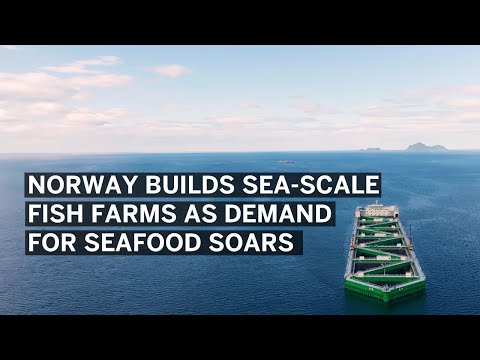“The world needs more fish and that means we have to take farming to the open sea,” says Therese Berg, member of the board, Nordlaks. Berg, who grew up on fish farms run by her father and witnessed the thirty-year growth of the industry in Norway’s fjords, exemplifies a new generation of environmentally conscious entrepreneurs focused on addressing the growing global demand for seafood while protecting marine ecosystems.
Salmon, the world’s second-most consumed fish after tuna, is revered for its rich content of protein and omega-3 fatty acids. The global salmon market is projected to reach US$46.8 billion by 2026, an increase of over one-third from 2020. But sustainable growth in the industry is dependent on environmental factors, and every salmon’s journey from hatchery to the table presents multiple challenges for producers.

Video by John Hunt
Berg understands that the foundation for Nordlaks’ long-term success is a healthy ecosystem and attending to the basic needs of the fish. “The welfare of the salmon is just as important as for other animals such as sheep and cows,” she says. “If the salmon have a good home with enough space to swim, current to swim against, good feed, and rest, their quality and taste will be good.”
Sea Farms: The New Frontier in Aquaculture
Norway’s fjords may appear plentiful, pristine, and empty to the casual observer, but the truth is that the fjords are approaching their limits for traditional aquaculture. To ensure the salmon thrive while reducing the impact on the ecosystem and surrounding communities, Norway has introduced some of the strictest environmental requirements for salmon farming. Aquaculture pods must be isolated from each other to ensure the health of the farmed salmon and other indigenous fish species.
The future of fish farming is therefore moving to the sea, and to this end Norway’s Ministry of Trade, Industry, and Fisheries is creating incentives for companies like Nordlaks to develop sustainable aquaculture solutions for exposed areas off Norway’s virtually endless coastline. Farming in exposed areas is viewed as the first step towards offshore fish farming.
In 2017, Nordlaks secured a development license to launch a large-scale fish farm capable of withstanding coastal waters. The result is the 385-meter vessel “Jostein Albert,” the world’s second-largest man-made floating structure (after the LNG production plant Prelude) and longer than the largest cruise ship. Its six nets hold up to 10,000 tons of salmon, or approximately two million fish. The design combines expertise from Norway’s maritime and aquaculture industries. To date, Nordlaks has invested nearly €400 million in offshore farms and related innovations.
Safe and Sustainable Operations with the Help of Digital Twins
To ensure the safety and environmental sustainability of the ocean farm, Nordlaks is also pioneering advanced digital technology.
For example, data from seven GPS sensors installed along the steel hull is fed into an identical mathematical model of the vessel that delivers precise measurements of the structural loads in near real time. This “digital twin” of the vessel enables Nordlaks to safely adapt operations to changing ocean conditions, for example during rough seas when the hull must be raised.
“We have to make sure that we don’t cause unnecessary strain or stress to the ocean farm when changing ballast to raise and lower the structure,” says Trond Jørgen Hanssen, ocean farm captain, Nordlaks. “The digital twin from SAP allows us to prevent unnecessary hogging and sagging of the structure.” Control is critical, because the difference in depth of the hull in the water between the maintenance position and the operational position is 12.5 meters.
The digital twin of the hull, built with the cloud-based solution SAP Enterprise Product Development, also keeps track of the cumulative loads on the structure over time, enabling operators to maximize the useful life of the vessel. “Over time we can see which parts of the vessel have experienced the most stress and introduce counter measures to maximize the life of the ocean farm,” says Hanssen. Designers can also use the data to verify their design parameters and optimize future hull designs.
The SAP solution also helps Nordlaks constantly monitor the integrity of the 11 anchors that are clustered at a single point under the bow of the vessel and the biological load on the sea floor. “Based on GPS data, we can map the areas where most of the feeding took place and concentrate our sample-taking in this area,” says Hanssen.
Fisheries Fuel Regional Growth
Nordlaks’ new vision for salmon farming and its investment in the region has already provided a significant boost to the local economy. Over two years, the number of Nordlaks employees in the municipality of Hadsel in the north of the country has increased by over one-quarter to around 700. According to Nordlaks, this is having a ripple effect in business activity and the company hopes it will help attract citizens from other parts of Norway to move to the picturesque region north of the Arctic Circle.
More people are needed, according to Berg, and she sees growth in the industry as an opportunity to make salmon an affordable source of protein for the entire world. “We don’t produce enough salmon today, which drives the price up. If we can produce more, then the price will be stabilized and the whole world will benefit from it,” she says. She is therefore calling for more people to join so salmon farming in the sea will be a global success. “If you have a skill, we need you in this industry!” says Berg.
Contributors to this story: Lars Fredrik Martinussen, Thomas Borvik Johnsen, Marit Reiso



